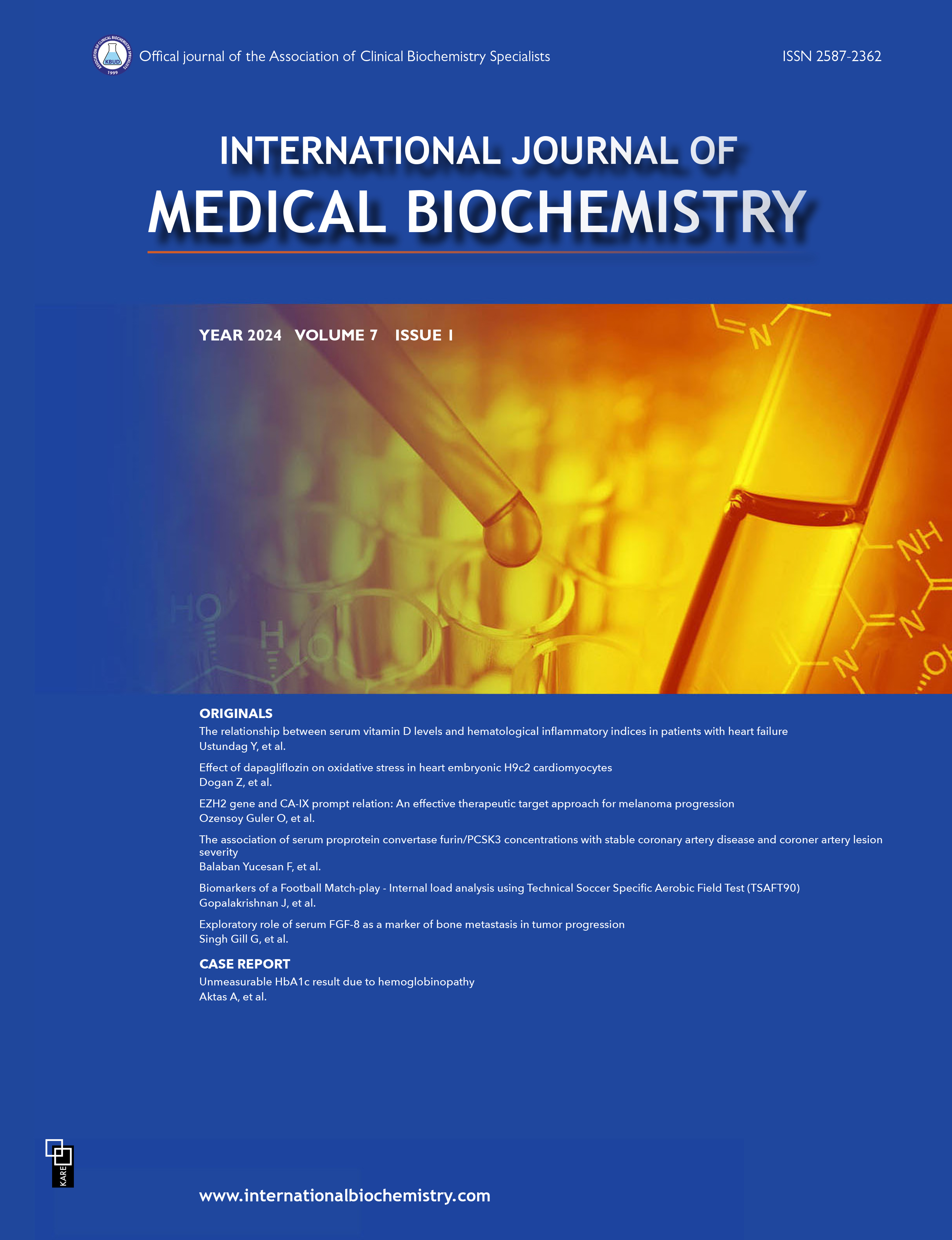Volume: 2 Issue: 1 - 2019
| ORIGINAL INVESTIGATION | |
| 1. | Plasma preptin levels in patients with type 2 diabetes mellitus Mehmet Kalayci, Ihsan Halifeoglu, Hatice Kalayci, Kader Ugur, Musa Yilmaz doi: 10.14744/ijmb.2018.74946 Pages 1 - 5 INTRODUCTION: Diabetes mellitus (DM) is a chronic disease characterized by hyperglycemia, and the prevalence is rapidly increasing worldwide. Preptin is a novel molecule with a metabolic effect that is secreted from pancreatic beta cells along with insulin. There are currently few studies about preptin in patients with type 2 DM (T2DM). This study was designed to observe differences in the plasma preptin level in patients with T2DM in comparison with a control group. METHODS: The study included 82 patients with T2DM (mean age: 49.00±5.97 years; 42 females, 40 males) and 65 healthy individuals (mean age: 41.98±5.62 years; 31 females, 34 males). The patients with T2DM were divided into 2 groups: those newly diagnosed and those previously diagnosed and in treatment. The previously diagnosed group was further separated into 2 groups based on their glycated hemoglobin (HbA1c) level: a well-controlled DM (HbA1C value <7%) group and a poorly controlled DM (HbA1C value >7%) group. The chemistry parameters were analyzed with an Advia 1800 analyzer (Siemens Healthineers, Erlangen, Germany), and hormonal parameters were analyzed with an Immulite 2000 analyzer (Siemens Healthineers, Erlangen, Germany). Plasma preptin levels were measured using the enzymelinked immunosorbent assay method. RESULTS: Patients with newly or previously diagnosed T2DM had significantly higher glucose, HbA1c, insulin, homeostatic model assessment of insulin resistance (HOMA-IR), total cholesterol, triglyceride, low-density lipoprotein cholesterol, and preptin values (p<0.001 for each), and significantly lower high-density lipoprotein cholesterol levels compared with the control group (p<0.001). The preptin level demonstrated a positive correlation with insulin, HOMA-IR, HbA1c, and glucose levels (for control group: r=0.452-p=0.000, r=0.472-p=0.000, r=0.389-p=0.001, r=0.286-p=0.021, respectively; for T2DM group: r=0.484-p=0.000, r=0.544-p=0.000, r=0.288-p=0.009, r=0.236-p=0.033, respectively). DISCUSSION AND CONCLUSION: The observed correlation between preptin level and DM a suggests that this peptide may have a possible role in the pathogenesis of DM, which may be particularly valuable, given that DM is a major public health problem. |
| 2. | Visfatin: A potential biomarker for the early diagnosis and monitoring of acute coronary syndrome Yesim Guvenc, Serap Cuhadar, Ozgur Bayturan, Cevval Ulman, Gonul Dinc Horasan, Ozan Utuk, Mahmut Acar doi: 10.14744/ijmb.2018.05925 Pages 6 - 12 INTRODUCTION: Acute coronary syndrome (ACS) is a major cause of mortality and morbidity worldwide; thus, early diagnosis is very important. The most common cause of ACS is the rupture of a vulnerable atherosclerotic plaque in the coronary artery, an occurrence in which inflammation plays a key role. The aim of the present study was to investigate visfatin as a proinflammatory biomarker in the early diagnosis and monitoring of ACS and to compare visfatins relationship with troponin T, tumor necrosis factor-alpha (TNF-α), and creatine kinase-MB (CK-MB). METHODS: Sixty ACS patients and 30 healthy control subjects were enrolled in this study. One blood sample was drawn from the control participants, and 3 were obtained from the ACS patients at intervals 0-6 hours (T0), 6-12 hours (T1), and 12-24 (T2) hours from the start of chest pain. Serum visfatin, TNF-α, troponin T, and CK-MB levels were assessed. Visfatin and TNF-α levels were assessed using enzyme-linked immunosorbent assay testing, troponin T was evaluated using chemiluminescence, and CK-MB by enzymatic methods. RESULTS: Serum TNF-α, troponin T, and CK-MB levels in the T0 blood samples were statistically significantly higher in the ACS patients compared with the controls (p=0.004, p<0.001, p<0.001, respectively). A significant positive correlation was observed between visfatin and troponin T (r=0.290, p=0.007) in the T0 samples. Visfatin concentrations were lower in the ACS group in the T0, T1 and T2 samples [4.01±6.23ng/mL, 1.80±3.47 ng/mL, and 1.72±2.67ng/mL, respectively; p=0.005; T0 >(T1=T2)]. DISCUSSION AND CONCLUSION: Visfatin had a significant positive correlation with troponin T. Visfatin did not demonstrate a rise and fall pattern like the standard biomarkers in terms of monitoring the progress of ACS patients, as there was a significant decrease after the first 6 hours. Although visfatin did not demonstrate superiority to troponin, its efficiency in a multimarker panel merits further evaluation. The role of visfatin in the early phase of pathophysiological mechanisms requires additional investigation. |
| 3. | The impact of magnesium on the glycemic regulation Murat Aksit, Merve Zeytinli Aksit, Banu Isbilen Basok doi: 10.14744/ijmb.2018.52724 Pages 13 - 18 INTRODUCTION: Magnesium is a cofactor for the phosphorylation of glucose and many other enzymatic reactions, and a deficiency can cause insulin resistance, carbohydrate intolerance, and dyslipidemia. A low serum magnesium level can lead to the development of diabetic complications, such as retinopathy, abnormal platelet function, cardiovascular disease, or hypertension. The aim of this study was to investigate the relationship between serum magnesium level and glucose regulation. METHODS: The results of serum level tests of glucose, magnesium, glycated hemoglobin (HbA1c), and insulin values, as well as a lipid panel, performed for 256 patients between January 2016 and December 2017 were retrospectively evaluated. The patients were divided into 3 groups: nondiabetic, prediabetic, and diabetic, according to the glucose and HbA1c levels specified in the 2017 American Diabetes Association criteria. Kruskal-Wallis H and Mann-Whitney U tests were used for intergroup comparisons. RESULTS: The patients who were nondiabetic (n=137), prediabetic (n=85), and diabetic (n=34) were aged (median [range]) 40 years (24-55), 45 years (35-58), and 48 years (30-57), respectively. There were significant differences between the nondiabetic and diabetic groups, as well as the prediabetic and diabetic groups, with respect to magnesium level (p<0.001 and p<0.001, respectively). No statistically significant difference was detected between the magnesium level of the nondiabetic and prediabetic groups. The magnesium level was significantly lower in the insulin resistant group (Homeostatic Model Assessment of Insulin Resistance [HOMA-IR] ≥2.5) (p=0.020). There was a significant negative correlation between magnesium level and glucose, HbA1c, and HOMA-IR values (r=0.244, p<0.001; r=0.332, p<0.001; and r=0.162, p=0.010, respectively). DISCUSSION AND CONCLUSION: Magnesium is a cofactor of various enzymes involved in carbohydrate oxidation and plays an important role in the transport of glucose to the cell membrane. In this study, it was observed that a low level of magnesium negatively affected glucose regulation. Magnesium-rich foods and/or oral magnesium supplementation may be beneficial in diabetic patients with reduced serum magnesium by increasing insulin sensitivity. |
| 4. | An approach to screening for macroprolactinemia in all hyperprolactinemic sera Nilhan Nurlu Ayan, Ela Keskin Temeloglu doi: 10.14744/ijmb.2018.66375 Pages 19 - 23 INTRODUCTION: Hyperprolactinemia is the most common endocrine disorder of the hypothalamo-pituitary axis and is a result of the over secretion of prolactin (PRL). The presence of the biologically inactive PRL isoform macroprolactin (MPRL) in serum causes interference in the PRL immunoassay, resulting in erroneously high PRL results. The presence of MPRL in serum can be detected using the simple, inexpensive, and routine polyethylene glycol (PEG) precipitation method. This study is an evaluation of the incidence of MPRL in hyperprolactinemic sera and the clinical symptoms and signs of hyper/macroprolactinemic patients. METHODS: The data of 73 hyperprolactinemic patients were retrieved from the laboratory information system and screened for the demographic details, clinical characteristics, and findings of the patients. RESULTS: Macroprolactinemia was detected in 13.7 % of the patients with hyperprolactinemia. The serum PRL, PRL percentage recovery, and diluted PRL percentage recovery values of macroprolactinemic patients after PEG precipitation were significantly lower than those of hyperprolactinemic patients (p<0.0001). While there was no significant difference in the percentage of infertility or headache cases among the hyperprolactinemic and macroprolactinemic patients, the percentage of oligo/amenorrhea, galactorrhea, and radiological findings (pituitary adenomas) was significantly greater in the hyperprolactinemic patients (p<0.0001). DISCUSSION AND CONCLUSION: Measurement of serum MPRL levels using routine PEG precipitation in hyperprolactinemic patients may be very effective in avoiding unnecessary tests and treatments during the diagnosis process and follow-up of patients. |
| RESEARCH ARTICLE | |
| 5. | Comparison of small-volume tubes and vacuum blood tubes for complete blood count Kubranur Unal doi: 10.14744/ijmb.2019.69188 Pages 24 - 29 INTRODUCTION: A complete blood count (CBC) is one of the most commonly requested clinical laboratory tests. Vacuum blood tubes are used routinely, and now, new small-volume tubes (SVTs) containing dipotassium ethylenediaminetetraacetic acid (K2EDTA) are also in use. The aim of this research was to compare SVTs with vacuum blood tubes for use in a CBC. METHODS: Venous blood samples were taken from 40 healthy volunteers and were collected in BD Vacutainer (Becton, Dickinson and Company, Franklin Lakes, NJ, USA) K2EDTA tubes and BD Microtainer (Becton, Dickinson and Company, Franklin Lakes, NJ, USA) K2EDTA tubes. CBC parameters were analyzed using an ABX Pentra DF 120 device (Horiba, Ltd., Kyoto, Japan). RESULTS: Red blood cells (RBC), hemoglobin (HGB), hematocrit (HCT), mean corpuscular hemoglobin (MCH), mean corpuscular hemoglobin concentration (MCHC), and basophil (BASO) levels were found to be statistically significantly higher, while platelet (PLT) levels were determined to be statistically significantly lower in the SVT analyses compared with those of the vacuum blood tubes. When the percentage difference was compared with the total allowable error, RBC, HGB, HCT, MCH, MCHC, red cell distribution width, white blood cell count, neutrophil, lymphocyte, monocyte, eosinophil, and BASO values demonstrated a general trend of positive bias, while PLT values demonstrated a general trend of negative bias on a Bland-Altman bias plot. DISCUSSION AND CONCLUSION: The results of this study demonstrated that venous blood samples from SVTs generated a significant bias in the CBC results. In addition, clotted samples were observed more frequently among those collected in SVTs in this study. The design of SVTs may have an important and detrimental effect on the accuracy and efficacy of the results of a CBC. |
| REVIEW | |
| 6. | A promising novel biomarker for embryogenesis and carcinogenesis: S100P protein Uzay Gormus doi: 10.14744/ijmb.2018.70288 Pages 30 - 34 Over the past decade, many great improvements have been achieved in cancer detection. Although there are many cancer biomarkers in use, unfortunately most of these biomarkers cannot yet be used efficiently for clinical purposes. Novel and reliable biomarkers are still required for the early detection and prognosis prediction of cancer. In many aspects, S100 calcium-binding protein P (S100P), a protein that is encoded by the S100P gene, is an interesting and promising marker that can enable the detection of many aggressive cancers in the early stages. S100P overexpression seems to be related to cancer aggression because of its capability to promote cell proliferation, invasion, and migration. Once we understand the molecular mechanisms better, S100P may be used as a specific biomarker and even a potential drug target for various cancers. The S100P protein is discussed in this review in relation to its functions and possible usage in the clinical area, mainly focusing on potential use in cancer research. |



















